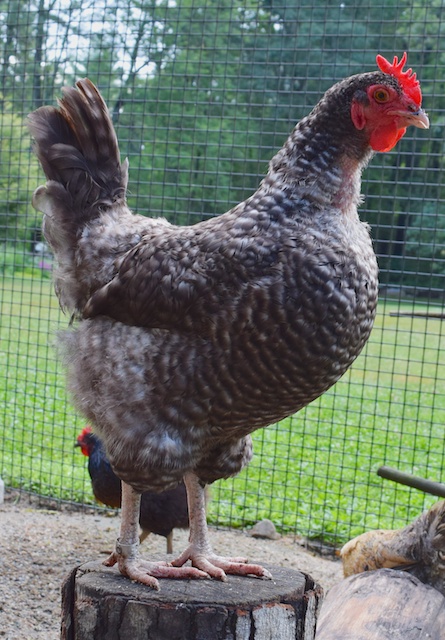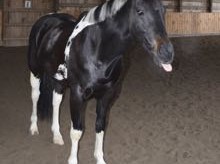A chicken can’t chew. She doesn’t have teeth. She does have a pointed, hard beak that pecks. Sometimes she breaks food into smaller bits with it, but often she takes in as large a chunk as she can swallow. She has a triangular tongue that fits perfectly inside of that beak. The tongue helps to push the food to the back and into the esophagus. Muscles help her to then move the food further down the digestive tract.
Chickens are designed to eat small amounts, constantly. That’s why feeding big handfuls of treats is a bad idea – hens need to be active and work for their food. Their systems aren’t made for eating a few distinct meals a day. But, sometimes what a hen swallows is big. I once saw Lulu slurp a baby snake down whole, like a strand of spaghetti. Sometimes hens find a bonanza of bugs in the garden and gorge themselves all in the course of a few minutes.
The first stop for all of this food in the digestive process is the crop – which is a pouch in the hen’s neck. Physically breaking down the food happens later, in the gizzard, which is a very powerful muscular sack, inside of which are tiny pebbles (grit) that the hen has swallowed on purpose. The gizzard effectively acts as a millstone to grind up food as coarse and hard as corn. The crop isn’t like the gizzard at all – it’s mostly just a holding area. Watch your hens over the course of the day, and you’ll see the crop change shape. This can be worrisome for a new chicken owner. A hen that looks like this:
will sport a huge and solid bulge like this:
It’s normal!
What isn’t normal is when that mass becomes impacted. This can happen when the hen eats long strands of grass, or too many sunflower seeds with the shells still on, or other such foods that get tangled up and hardened in the crop. If that happens, your hen will show signs of distress. She’ll stretch her neck. She’ll become listless. She might look panicked (as one of my hens did when she got a long, tough leek stuck in her.)
If your hen is impacted (and not just a glutton, as Veronica in the above photos – she’d just come in after a glorious afternoon of free-ranging), then there are a few things that you can do. You can massage the crop to try to break up the mass and move things along. You can also feed her olive oil, either by soaking some food with it, (if she’s still eating) or by carefully dosing her. (See my YouTube video.) Crop impaction is serious. I’ve done a necropsy on a hen that died from impaction. It was a friend’s bird and what I found out was that she had gorged on long grasses and leftover garbanzo bean curry (fed to the hens with the kitchen scraps.) What the hen didn’t have in her crop were laying hen pellets. That’s why I like to see my hens eat easy to digest pellets before going free-ranging. I think that it reduces the risk that they’ll gorge on the wrong stuff.
In any event, impactions are rare. What is normal is a healthy, happy hen with a ridiculously bulging crop. Don’t worry about her.



My goat, Frank, gets a huge bulge on one side after an extended period of grazing. It subsides after a couple of hours of lounging and digesting. My other goat, Beans, does not chow down like his buddy and he always looks normal. Are hens the same? Will some always be gluttons and other more picky eaters? Or do all hens try to eat as many calories as they can in order to produce eggs?
The rumen is on the left side, and yes, it does distend! Just like with goats, some hens eat more than others. Some is personality, some is that the better layers need more nutrients – hence Twiggy eats constantly, but always looks sleek.
Terry have you ever seen a hen swallow a field mouse (not a house mouse) whole?
A sight indeed. I would not have believed it had I not seen it with my two eyes.
Impaction is exactly what I worried about but somehow it worked its way through.
Yes, I’ve seen mice eaten, as well as whole frogs!
I have hen that eats whole frogs. So far just smaller ones. Ewwww! But she loves them.
Your wisdom serves me everyday…..I have a squirrel who tips my sunflower seeds on my cardinals, and the girls luv it thinking it’s Christmas…….I will hang the feeder in another spot! Never knew seeds could hurt my darlings!
In small quantities the hens can handle them, but not in large amounts. The other reason to move the feeder is that wild birds can bring in diseases. Also, seed spilled at the base of feeders can go moldy, which can also make your hens sick.
An occasional feed of maggots helps clear a crop … I had a hen with a pendulous crop and maggots kept her crop soft, avoiding impaction.
Sorry, but the gross factor would keep me from doing that – as well as not wanting maggots around!
Shall I gross you out further? Doctors use maggots to clean wounds!
And I had absolutely no idea that chickens would eat mice and frogs! And that they can actually get them down! Wow.
I know. Rather effective. Leeches have their purposes, too. Ugh.
Yuk, enough already, I’m already nauseous from the heat and humidity. :)
They are a great source of protein and minerals.
My family, friends, coworkers are immediately grossed out when I tell them that chickens will eat chicken. And with gusto I might add.
Holy crap!
Once I saw one of my Barred Rocks swallow a lizard just like spaghetti. I would have freaked out if it had been a snake.
Can you remind me which brand(s) pellets you find work well for you for a backyard flock kept as pets? I have been noticing that certain brands advertise they have vegetarian ingredients no animal fat etc and others do not. It is time for me to buy a new bag and I want to be sure I am making the best choice.
There are regional feed mills, and I’m not familiar with those in California. Here on the east coast, I like to use Poulin Grain products. Although it sounds like a good idea to buy organic, I’ve heard from many people who have had serious health issues – not because of the ingredients, but because the feed often isn’t pelleted, and the hens pick and choose what to eat and don’t eat a balanced diet. Also, be careful that chick starter is pelleted before being made into crumbles, or you’ll have crop issues. Always get laying hen pellets for your layers. “Show bird” and “grower” have the wrong amount of protein, etc.
Oh, that’s interesting! I’ve been buying Modesto Milling Organic crumbles and I’ve noticed that the feeder is full of mostly powder. The ingredients are great but how do you tell if the food was pelleted before being crumbled?
Powder isn’t good, either. Crumbles should be the consistency of Grape-nuts cereal. What you don’t want are obvious whole grains, or the birds will pick out what they like and toss the rest to the ground.
Mine toss a lot to the ground so I am definitely checking on this when I get home tonight.